Constant scientific research and experimentation have provided humans with exceptional innovations. These technologies can reshape human lives and streamline operations for several commercial sectors. Artificial Intelligence (AI) stands at the forefront of technological innovation. AI mimics human cognitive functions through various components that enable learning, reasoning, problem-solving, perception, and language understanding. Multinational corporations and advanced research facilities have joined forces to embark on a journey toward an AI-enabled future. In this article, readers will delve into the intricacies of the essential components of AI and will shed light on how they contribute to the advancement of AI technology.
- Learning:
One fundamental pillar of AI is learning. Learning is one of the components of AI that process akin to human cognitive development. Within the realm of AI, learning takes on diverse forms, with the trial-and-error method being a crucial component. This approach involves relentless problem-solving until optimal results are achieved. The program meticulously records successful moves in its database, creating a repository for future encounters with similar problems.
Rote learning, another facet of AI learning, involves memorizing specific items such as problem solutions, vocabulary, or foreign languages. This memorization is later generalized, enhancing the AI's overall understanding and application capabilities.
- Reasoning:
Reasoning is considered exclusive to humans. It is one of the pivotal components of AI. Reasoning allows AI platforms to draw inferences based on given situations, categorizing these inferences as either inductive or deductive. The ability to differentiate between the two types of reasoning is critical in ensuring the accuracy of AI-driven conclusions.
Deductive inferences, employed in programming computers, have yielded considerable success. However, effective reasoning in AI necessitates the extraction of relevant inferences from the presented scenario.
- Problem-Solving:
AI's problem-solving ability revolves around manipulating data to find solutions. This component encompasses both special-purpose and general-purpose methods. Special-purpose methods tailor solutions to specific problems, leveraging unique features embedded in the given scenario. General-purpose methods address a broader range of issues, employing step-by-step reduction to bridge the gap between the current state and the goal state.
- Perception:
Perception is one of the components of AI that involves scanning environments using artificial or real sense organs. This process enables the analysis of scenes, identification of objects, and understanding of their relationships and features. Although perception in AI has advanced, challenges remain, especially when similar items present varied appearances based on different perspectives.
- Language Understanding:
Language understanding is a vital AI component that enables computers to comprehend human languages, such as English. This proficiency allows AI to interpret and execute various computer programs. Language understanding relies on distinctive types of language, including natural language, with a focus on semantics and nuances.
- Supervised Learning:
Supervised learning, a prevalent form of machine learning, trains algorithms to interpret input data at an effective rate. This method utilizes labeled data to guide algorithms, making them proficient in tasks like classification and regression. Applications of supervised learning abound, from recognizing speech and face to deciphering handwriting and gestures.
- Unsupervised Learning:
In contrast to supervised learning, unsupervised learning utilizes unlabeled data for training. This trial-and-error method uncovers unknown data features and patterns, facilitating categorization. Unsupervised learning broadly falls into association problems and clustering, enabling AI to pose questions and discover relationships among variables in vast databases.
- Semi-Supervised Learning (SSL):
Semi-supervised learning bridges the gap between supervised and unsupervised learning. It proves invaluable when reference data is available but may need to be more accurate or complete. SSL utilizes both labeled and unlabeled data, employing a balanced approach to find solutions, reduce biases, and enhance learning outcomes.
- Reinforcement Learning:
Reinforcement learning, a dynamic process, enables systems to train algorithms through reward and punishment mechanisms. Algorithms learn by interacting with their environment, receiving rewards for correct operations and penalties for suboptimal performance. With three key components agent, environment, and actions. Reinforcement learning focuses on maximizing rewards and minimizing penalties for autonomous learning.
Summing Up
As the modern world navigates the complex landscape of artificial intelligence, understanding the components of AI becomes paramount. Learning, reasoning, problem-solving, perception, language understanding, and various learning paradigms collectively shape AI's evolution. These components mirror human cognitive processes and also drive the technological advancements that propel AI into new frontiers. The future promises continued innovation as AI enhances its capabilities and redefines human relationships with technology. Brilliant minds of the modern era supported with adequate resources focus their intellect on bringing out the best of their abilities through advances in science and its byproducts.


No comments yet